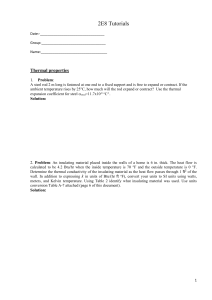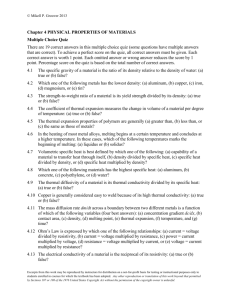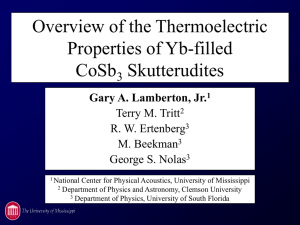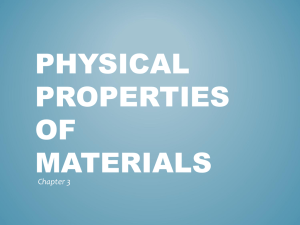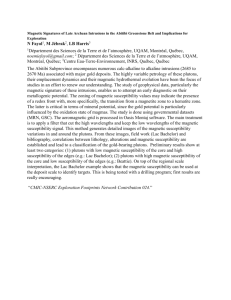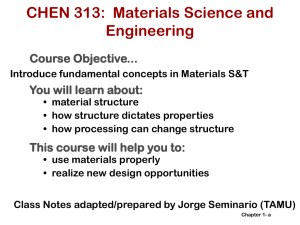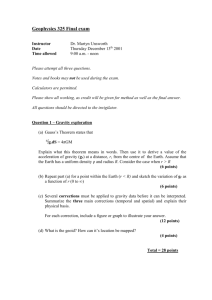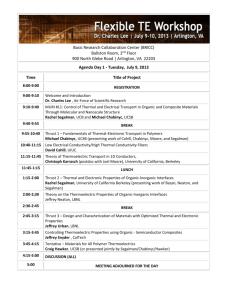Experimental methods for the determination of electrical and thermal
advertisement
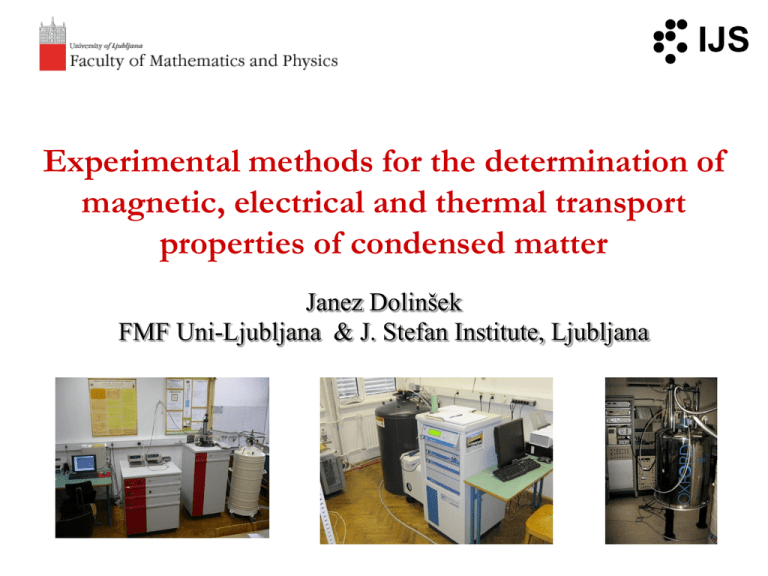
Experimental methods for the determination of magnetic, electrical and thermal transport properties of condensed matter Janez Dolinšek FMF Uni-Ljubljana & J. Stefan Institute, Ljubljana Magnetic, electrical and thermal transport properties - Magnetic susceptibility Electrical resistivity Thermoelectric power Hall coefficient Thermal conductivity Introduction • Why to measure magnetic, electrical and thermal transport properties of solid materials ? • Ever-present demand for new materials with novel/improved physical-chemical-mechanical properties • Novel materials preparation techniques were developed • High-quality single crystals available • Complex metallic alloys (CMAs) and quasicrystals (QCs) offer unique physical properties or combinations of properties Electrical conductor + thermal insulator Combination of hardness + elasticity+ small friction coefficient • Potential applications in high technology Complex Metallic Alloys • • • • Intermetallic compounds Giant unit cells Cluster arrangement of atoms Inherent disorder: • Configurational • Chemical or substitutional • Partial or split occupation Mg32(Al,Zn)49 quasicrystals YbCu4.5 Ψ-Al-Pd-Mn β-Al3Mg2 λ-Al4Mn Al39Fe2Pd21 Mg32(Al,Zn)49 Re14Al57 elem. metals ∞ 7448 at. / u. c. 1480 at. / u. c. 1168 at. / u. c. 586 at. / u. c. 248 at. / u. c. 162 at. / u. c. 71 at. / u. c. <5 at. / u. c. Quasicrystals • Discovered in1984 • Thermodynamically stable samples have appeared after 1990 • Well-ordered but nonperiodic solids • Diffraction patterns with non-crystallographic point symmetry Periodic tiling Penrose tiling (quasiperiodic) Diffraction pattern of a decagonal quasicrystal Sample preparation Bridgman method Czochralski method Flux-grown method •The first solidification zone •Coexistence of solid and liquid phases Single-crystal is cut in bar-shaped samples Al-Co-Ni decagonal QC Czochralski method Experimental methods Magnetization and magnetic susceptibility measurement M … magnetic susceptibility H SQUID magnetometer 5 T Experimental methods Measurement of the electrical conductivity Electrical resistance: R = U/I Specific resistivity: S R l PPMS – Physical Property Measurement System 9 T Experimental methods Thermoelectric effect Experimental methods Measurement of the thermoelectric power Thermal conductivity measurement U ST q j P S T Experimental methods Measurement of the Hall coefficient Hall coefficient RH RH H B Ey jx B UH d I B 1 ne Magnetization vs. magnetic field Y-Al-Ni-Co o-Al13Co4 M M 0 L ( , H , T ) kH FM contribution linear term i-Al64Cu23Fe13 Al4(Cr,Fe) ferromagnetic component M M 1 B ( g 1 , J 1 ) M 2 B ( g 2 , J 2 ) kH Curie magnetizations linear term Magnetic susceptibility Y-Al-Ni-Co i-Al64Cu23Fe13 temperature-independent term (T ) 0 C T Curie-Weiss susceptibility A2T temperature-independent term 0j C j T j Curie-Weiss susceptibility A4T 4 temperature-dependent correction o-Al13Co4 Al4(Cr,Fe) 2 Electrical resistivity Y-Al-Ni-Co o-Al13Co4 PTC of the resistivity – predominant role of electron-phonon scattering mechanism (Boltzmann type) Electrical resistivity Al4(Cr,Fe) i-Al64Cu23Fe13 is nonmetallic with NTC slow charge carriers vτ L wp j Bj NBj L j ( j ) 2 2 2 j 2 e g ( F ) v j e g ( F ) j pseudogap in () specific distribution of Fe 1 ( ) A 1 1 2 2 1 1 2 2 2 2 2 Thermoelectric power Y-Al-Ni-Co Al4(Cr,Fe) o-Al13Co4 i-Al64Cu23Fe13 Hall coefficient • RH values of QCs and CMAs are typical metallic • RH’s exhibits pronounced anisotropy • Fermi surface is strongly anisotropic • consists of hole-like and electron-like parts Y-Al-Ni-Co Al4(Cr,Fe) o-Al13Co4 Thermal conductivity • Total is a sum of the electronic el and the phononic ph contribution • el is estimated from the Wiedemann-Franz law: el=2kB2T(T)/3e2 • WF law valid when elastic scattering of electrons is dominant Y-Al-Ni-Co o-Al13Co4 Al4(Cr,Fe) Thermal conductivity i-Al64Cu23Fe13 electronic part hopping of localized vibrations (T ) el (T ) D (T ) H (T ) long wave phonons (Debye model) • 300K < 1.7 W/mK lower than SiO2 (2.8 W/mK) Thank you for your attention !


